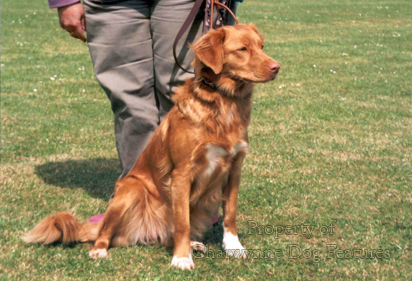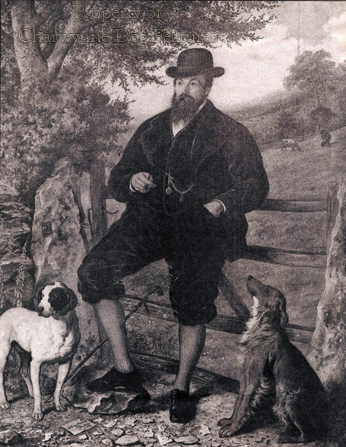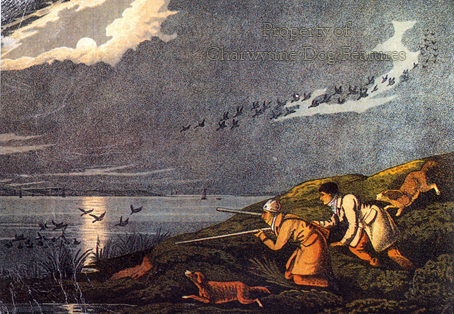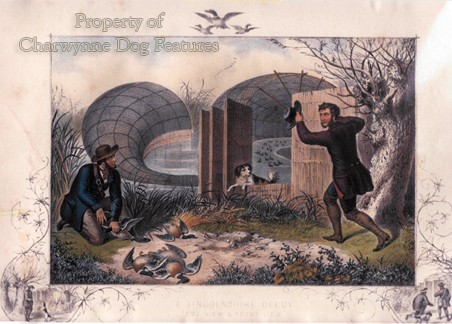478 Decoy Dogs
RECALLING THE RED DECOY DOG
by David Hancock
 How valuable must have been the dogs which accompanied settlers to 'new' countries in past centuries. Hounds, gundogs and herding dogs must have been a godsend to those carving out a new life in primitive conditions. The dogs the settlers brought with them would not conform to any contemporary standard but earned their keep and were valued for what they could do, not what they looked like. Bob-tailed shorter-haired collies may now be called Australian Shepherds and been developed as a breed in North America. But the breed-type has long been known in Britain and is still favoured in the Black Mountain on the English-Welsh border. The Chesapeake Bay Retriever may well be the sandy-brown rust-coloured Norfolk Retriever transported and the Nova Scotia Duck Tolling Retriever the Red Decoy Dog of the Fens resettled in a new location.
How valuable must have been the dogs which accompanied settlers to 'new' countries in past centuries. Hounds, gundogs and herding dogs must have been a godsend to those carving out a new life in primitive conditions. The dogs the settlers brought with them would not conform to any contemporary standard but earned their keep and were valued for what they could do, not what they looked like. Bob-tailed shorter-haired collies may now be called Australian Shepherds and been developed as a breed in North America. But the breed-type has long been known in Britain and is still favoured in the Black Mountain on the English-Welsh border. The Chesapeake Bay Retriever may well be the sandy-brown rust-coloured Norfolk Retriever transported and the Nova Scotia Duck Tolling Retriever the Red Decoy Dog of the Fens resettled in a new location.
The dog used as a decoy in duck hunting often worked in partnership with tame ducks to entice their wild relatives along ever-narrowing netted or caged channels until they were made captive. Jesse in his exhaustive "Researches into the History of the British Dog" of 1866 described how, in the Fens of Essex, dogs resembling the "colly" were used with tame ducks to entice wildfowl into tunnel-nets. Throw-backs to this collie-like red-coated lavishly-tailed clever agile dog still occur in country areas; their luxuriantly-furnished tails are flourished exorbitantly when alert to feathered game. There were once as many as 188 duck-decoys located in England, mainly in the eastermost counties.
In Payne-Gallwey's book on duck-decoys of 1886 there is a good depiction of a red decoy dog, working with a black water dog; it displays the appealing red-gold coat once common in Golden Retrievers before it was diluted in a closed gene pool. I see this colour in working Cockers but, not being favoured by show fanciers, it is not bred for, despite its distinctive hue. This coat colour is remarkably difficult to pick up when working gundogs or patrolling with guard dogs at night. Coat colour matters more in working conditions than many show breeders realise. A heavily-feathered tail also has its uses, not just as a rudder in water or in providing balance on tight turns. 
The skill of the decoy dog lies in giving the inquisitive ducks only fleeting and seemingly tantalising glimpses of its progress, usually its tail's progress, through the reeds and undergrowth, taking great care never to frighten them or even give them cause for suspicion. Before the use of firearms and indeed in the days when their range was very limited, these dogs must have been enormously valuable to duck-hunters. For the humbler hunters they represented the difference between eating or starving. In the 19th century, just 10 decoys around Wainfleet in Lincolnshire produced 31,200 head in one season, mostly for the London markets.
The distinctive feature of dogs used in this way was the well-flagged tail. Their colour was usually fox-red, leading to some being referred to as fox-dogs, partly also because foxes will entice game by playful antics in a very similar vein. Clever little fox-like dogs have been used in many different countries in any number of ways in the pursuit of game: in Finland, their red-coated bark-pointer Spitz breed transfixes feathered game by its mesmeric barking whilst awaiting the arrival of the hunters; in Japan, the russet-coated Shiba Inu was once used to flush birds for the falcon and the Tahl-tan Indians in British Columbia hunted bear, lynx and porcupine with their little black bear-dogs, which were often mistaken for foxes.
In his Duck Decoys (Shire Album 361) of 2001, Andrew Heaton writes on decoy-dogs: 'A dog trained and used in working a decoy in this manner needs to be extremely obedient, able to respond to silent commands and carry out its duties without taking notice of the encroaching wildfowl. The dogs were traditionally given the name of Piper. Such dogs tended to be fox-like in form, small with a bushy tail and a reddish colouration.' Ferrets, cats, tame foxes and even a rabbit have been tried in this role but proved untrainable. The Kennel Club's standard for the breed of Nova Scotia Duck Tolling Retriever stipulates that the breed should be easy to train, with a constantly moving heavily feathered tail, and playful. I do hope the breed retains the red-gold coat and does not become off-white like the Golden Retriever. Small red-coated retrievers were once very common in Britain and depicted by such artists as Ferneley, Van Dyck and Shuckard.
At the end of the 19th century "ginger 'coy dogs" were frequently to be seen alongside the lurchers in gypsy camps, especially in East Anglia. James Wentworth Day, the celebrated country sports writer, refers to them in his 'The Dog in Sport' of 1938, linking them with the 'Fen Tigers', the rough countrymen who cut sedge and dug peat from the Fens and were skilled wild-fowlers. In his mammoth 'ultimate dictionary of over 1,000 dog breeds' Desmond Morris describes the Red Decoy Dog as a small rufous dog employed to lure wildfowl into nets and suggests that their behaviour in doing so was modelled on comparable behaviour in foxes. Because no pedigree breed in this mould has been handed down to us, very little reference is made nowadays to these gifted and at one time invaluable dogs, rather as the ancient water-dogs are rarely acknowledged in the histories of our gundog breeds. Both decoy-dogs and water-dogs were usually handled by the humbler hunters like farm labourers and gypsies and so very little has been written about them.
In Europe it seems that the Dutch in particular had perfected the art of duck decoying, with the word itself coming from their word endekoy, a duck cage. The first duck decoy in Britain was built by a Dutchman, Hydrach Hilens, just over three hundred years ago in St James's Park for Charles the Second. Such a decoy usually consists of a small shallow pond secluded by trees with a number of "pipes" leading off it, each about 60 metres long. These pipes or caged tunnels are six metres wide and four metres high at their entrance but narrowing right down to the decoyman's net. 
Along the curve of the pipe the decoyman (or kooiker in Holland) is concealed behind reed-screens. One of the few remaining in Britain is a joint venture between the National Trust and the Berkshire, Buckinghamshire and Oxfordshire Naturalists' Trust at Boarstall. This decoy is marked on the 1697 map of the Manor of Boarstall in the Buckinghamshire County Record Office. Tame "call ducks" are no longer used here but Daniel White who once worked this decoy for over 60 years used six large Rouen call ducks. The yearly average of duck taken here at the end of the 19th century was 800. I believe there are only four kooikers still operating in Holland but they have retained their specialist breed of decoy dog, the Kooikerhondje, a small red and white spaniel-like dog; one of these is now working at the Boarstall decoy. In England we appear to have lost our native red-coated decoy dog which surely could still have been useful if only to those wishing to ring, photograph, paint or just study wild duck.
The Welsh have their springer spaniel and the French their Brittany, both featuring that attractive rich red with white coat, although the French dogs are more often red-roan. To see a sporting dog in this rich red hue, working in the sunshine, active and enthusiastic, is for me one of the most satisfying sights on any shoot. Their coats seem to glow with health and vigour. It is often a colour favoured by wildfowlers and may be more than a preference in colour; so many breeds with waterproof coats have a reddish look to them. The old Norfolk Retriever was said to have had a reddish coat, as did the Tweed or Ladykirk Spaniel, the Norfolk or Shropshire Spaniel and the English Water Spaniel. They live on in our surviving gundog breeds perhaps but we have lost part of our sporting dog inheritance. One day a keen wildfowler might take on the worthy task of re-creating them; that would be an appreciable contribution to our fast-disappearing canine sporting heritage.